You’ve reached a crossroads with HubSpot CRM. The platform that once seemed like the perfect fit for your team now feels more like a square peg in a round hole. It’s either become too cumbersome or too costly or perhaps it’s just not aligned with your evolving needs.
The prospect of leaving HubSpot can be daunting, but sometimes, it’s the best decision for your team’s effectiveness and efficiency.
Here’s how to recognize when it’s time to make a switch and what steps to take to ensure a smooth transition to a new CRM.
When to leave HubSpot CRM?
Let’s dive into the scenarios that signal it’s time to leave HubSpot CRM and what steps you can take to transition smoothly.
Reason #1: The challenge of rising costs
One of the main reasons companies outgrow HubSpot CRM is the escalating cost as they scale. While HubSpot offers a free version, most businesses quickly move beyond the free tier and into its paid plans. As your team expands and you need access to more features—such as sales automation, advanced reporting, or customer support tools—the costs can add up quickly.
The jump from the free plan to HubSpot’s paid tiers can be steep, with higher-tier plans costing hundreds or even thousands of dollars per month. And while these features may be valuable, businesses often find themselves paying for tools they don’t fully utilize or need.
Consider migrating to a CRM like Salesmate that offers more flexible pricing plans or one that’s better suited to your specific business needs. Look for platforms that allow you to customize features so you’re only paying for what you use.
Reason #2. Multiple licenses for cross-functionality
If your business involves both marketing and sales, HubSpot can become unnecessarily expensive. For example, a salesperson needing access to marketing tools (or vice versa) requires separate licenses. So, instead of paying for one all-encompassing license, you’re stuck purchasing multiple seats for different departments, adding to your overall expenditure.
HubSpot’s CRM does not allow cross-functionality between their marketing, sales, and service hubs under one license. This means that each department needs its own set of tools, which in turn drives up the cost. In contrast, Salesmate provides a seamless experience, enabling one user to access all essential functionalities.
Reason #3. Frustration with integration and customization
While HubSpot offers a range of integrations, you might find yourself constantly juggling multiple tools to get the functionality you need. If you’re spending more time managing integrations and workarounds than actually using the CRM effectively, it might be a sign that you need a more integrated and customizable solution.
Seek out CRMs like Salesmate that offer seamless integration with your existing tools and greater flexibility in customization.
Reason #4. Your team is struggling with adoption
If your team is having trouble adapting to HubSpot or if they find the system cumbersome, it’s a clear indication that the CRM might not be the right fit. A CRM should enhance your team’s productivity, not hinder it.
Consider switching to a CRM that aligns better with your team’s workflow and offers a more intuitive user experience.
Reason #5. Your strategy has evolved
If you’re implementing new sales strategies, methodologies, processes, or budget, and HubSpot isn’t supporting these changes effectively, it’s time to look for a solution that can better align with your new approach.
How to leave HubSpot CRM?
1. Assessing your current situation
Before making the switch, evaluate your current CRM setup and identify what’s lacking. Define what you need from a new CRM and set clear objectives for the transition.
- Research competitors: Compare HubSpot with other CRM software to see if they offer better features, pricing, or scalability.
- Test new solutions: Use trials or demos to evaluate if another CRM aligns better with your needs.
2. Planning your exit strategy
Once you’ve decided to leave HubSpot CRM, plan your exit strategy carefully:
- Backup your data: Ensure you have a complete backup of your CRM data before starting the migration process.
- Update integrations: Ensure that your new CRM integrates with your existing tools and systems to avoid disruptions.
- Test integrations: Conduct thorough testing to ensure that all integrations function as expected with the new CRM.
- Prepare your team: Provide training sessions and resources to help your team transition to the new CRM.
- Develop onboarding materials: Create onboarding materials and guides to ease the transition for your users.
3. Executing the transition
Effective execution of the transition is crucial for minimizing disruptions:
- Monitor performance: Track the performance of the new CRM and address any issues promptly.
- Inform your team: Keep your team informed about the transition timeline, new processes, and any changes.
- Update clients and partners: Notify clients and partners if the transition impacts their interactions with your business.
4. Post-transition review
After the transition is complete, review the process and make necessary adjustments:
- Assess CRM performance: Evaluate how well the new CRM meets your needs compared to HubSpot.
- Gather feedback: Collect feedback from your team to identify any areas for improvement.
- Refine workflows: Optimize workflows and processes based on the new CRM’s capabilities.
- Continuous improvement: Regularly review and update your CRM usage to ensure it continues to meet your evolving needs.
Why Salesmate might be a better alternative?
If you’re feeling restricted by HubSpot’s pricing structure, lack of cross-functionality, or expensive add-ons, it may be time to consider a more affordable, flexible alternative like Salesmate.
1. Reasonably priced and user-friendly
Salesmate offers a powerful CRM solution at a fraction of the cost of HubSpot. Our pricing is straightforward and doesn’t involve the added cost of separate licenses for marketing, sales, or support. Whether you’re managing relationships, sales pipelines, or automating marketing efforts, Salesmate users get access to the entire platform.
Our customers consistently rave about how easy our platform is to use. The simplicity of our CRM allows businesses to scale without the complexity and high cost associated with premium-priced software like HubSpot.
2. Everything you need, built-In
Salesmate has built-in tools for driving business relationships without the hassle of integrating multiple apps. With features like email automation, workflow management, sales forecasting, and custom reporting, you can manage everything within one platform. No need to pay for separate add-ons, which saves you money and streamlines your operations.
3. Best-in-class customer support
Unlike HubSpot, Salesmate offers superior customer support without extra fees. Our support team is always ready to help you get the most out of your CRM. Whether it’s a simple question or technical assistance, you’ll find that our support is not only responsive but also one of the best in the CRM industry.
The shortcomings of Salesmate
Of course, no CRM is perfect. While Salesmate has many advantages, there are areas where HubSpot outshines us:
- Community size: HubSpot has a much larger community, meaning more available integrations, support forums, and user-generated content.
- Advanced features: HubSpot offers some features that Salesmate currently doesn’t, such as landing pages, a built-in CMS Hub, and a Commerce Hub. However, these features are often overkill for businesses that don’t need such specialized tools.
Conclusion
Leaving HubSpot CRM might seem like a daunting task, but with careful planning and the right support, it can lead to significant improvements in your sales processes and overall effectiveness.
If you’re ready to explore a more tailored solution, contact us to see how Salesmate can provide a seamless transition and help you achieve your sales goals with greater efficiency.

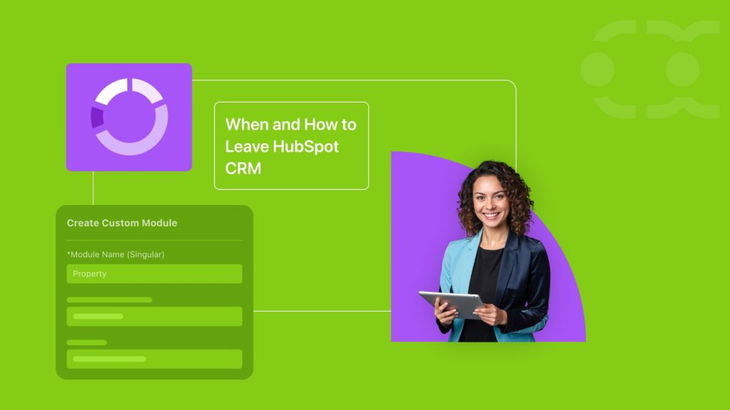

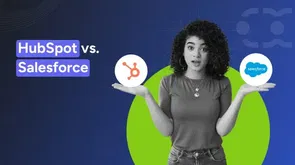
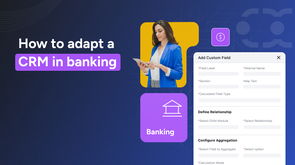
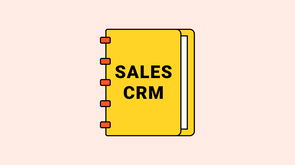
You’ve reached a crossroads with HubSpot CRM. The platform that once seemed like the perfect fit for your team now feels more like a square peg in a round hole. It’s either become too cumbersome or too costly or perhaps it’s just not aligned with your evolving needs.
The prospect of leaving HubSpot can be daunting, but sometimes, it’s the best decision for your team’s effectiveness and efficiency.
Here’s how to recognize when it’s time to make a switch and what steps to take to ensure a smooth transition to a new CRM.
When to leave HubSpot CRM?
Let’s dive into the scenarios that signal it’s time to leave HubSpot CRM and what steps you can take to transition smoothly.
Reason #1: The challenge of rising costs
One of the main reasons companies outgrow HubSpot CRM is the escalating cost as they scale. While HubSpot offers a free version, most businesses quickly move beyond the free tier and into its paid plans. As your team expands and you need access to more features—such as sales automation, advanced reporting, or customer support tools—the costs can add up quickly.
The jump from the free plan to HubSpot’s paid tiers can be steep, with higher-tier plans costing hundreds or even thousands of dollars per month. And while these features may be valuable, businesses often find themselves paying for tools they don’t fully utilize or need.
Consider migrating to a CRM like Salesmate that offers more flexible pricing plans or one that’s better suited to your specific business needs. Look for platforms that allow you to customize features so you’re only paying for what you use.
Reason #2. Multiple licenses for cross-functionality
If your business involves both marketing and sales, HubSpot can become unnecessarily expensive. For example, a salesperson needing access to marketing tools (or vice versa) requires separate licenses. So, instead of paying for one all-encompassing license, you’re stuck purchasing multiple seats for different departments, adding to your overall expenditure.
HubSpot’s CRM does not allow cross-functionality between their marketing, sales, and service hubs under one license. This means that each department needs its own set of tools, which in turn drives up the cost. In contrast, Salesmate provides a seamless experience, enabling one user to access all essential functionalities.
Reason #3. Frustration with integration and customization
While HubSpot offers a range of integrations, you might find yourself constantly juggling multiple tools to get the functionality you need. If you’re spending more time managing integrations and workarounds than actually using the CRM effectively, it might be a sign that you need a more integrated and customizable solution.
Seek out CRMs like Salesmate that offer seamless integration with your existing tools and greater flexibility in customization.
Reason #4. Your team is struggling with adoption
If your team is having trouble adapting to HubSpot or if they find the system cumbersome, it’s a clear indication that the CRM might not be the right fit. A CRM should enhance your team’s productivity, not hinder it.
Consider switching to a CRM that aligns better with your team’s workflow and offers a more intuitive user experience.
Reason #5. Your strategy has evolved
If you’re implementing new sales strategies, methodologies, processes, or budget, and HubSpot isn’t supporting these changes effectively, it’s time to look for a solution that can better align with your new approach.
How to leave HubSpot CRM?
1. Assessing your current situation
Before making the switch, evaluate your current CRM setup and identify what’s lacking. Define what you need from a new CRM and set clear objectives for the transition.
2. Planning your exit strategy
Once you’ve decided to leave HubSpot CRM, plan your exit strategy carefully:
3. Executing the transition
Effective execution of the transition is crucial for minimizing disruptions:
4. Post-transition review
After the transition is complete, review the process and make necessary adjustments:
Why Salesmate might be a better alternative?
If you’re feeling restricted by HubSpot’s pricing structure, lack of cross-functionality, or expensive add-ons, it may be time to consider a more affordable, flexible alternative like Salesmate.
1. Reasonably priced and user-friendly
Salesmate offers a powerful CRM solution at a fraction of the cost of HubSpot. Our pricing is straightforward and doesn’t involve the added cost of separate licenses for marketing, sales, or support. Whether you’re managing relationships, sales pipelines, or automating marketing efforts, Salesmate users get access to the entire platform.
Our customers consistently rave about how easy our platform is to use. The simplicity of our CRM allows businesses to scale without the complexity and high cost associated with premium-priced software like HubSpot.
2. Everything you need, built-In
Salesmate has built-in tools for driving business relationships without the hassle of integrating multiple apps. With features like email automation, workflow management, sales forecasting, and custom reporting, you can manage everything within one platform. No need to pay for separate add-ons, which saves you money and streamlines your operations.
3. Best-in-class customer support
Unlike HubSpot, Salesmate offers superior customer support without extra fees. Our support team is always ready to help you get the most out of your CRM. Whether it’s a simple question or technical assistance, you’ll find that our support is not only responsive but also one of the best in the CRM industry.
The shortcomings of Salesmate
Of course, no CRM is perfect. While Salesmate has many advantages, there are areas where HubSpot outshines us:
Conclusion
Leaving HubSpot CRM might seem like a daunting task, but with careful planning and the right support, it can lead to significant improvements in your sales processes and overall effectiveness.
If you’re ready to explore a more tailored solution, contact us to see how Salesmate can provide a seamless transition and help you achieve your sales goals with greater efficiency.
Pawan Kumar
Marketing HeadMarketing Head at Salesmate | Digital Storyteller | Poll Enthusiast | 📈 Data-Driven Innovator | Building bridges between tech and people with engaging content, stories, and creative marketing strategies. Let's turn ideas into impact! 🌟